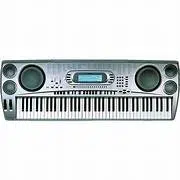Loading ...
Loading ...
Loading ...

A-8
733A-E-088A
Chord Conversion Table
• The applicable chord conversion table depends on the particular combination of elements and parts. The symbol in the table
below indicates that a chord table is applicable, while indicates that a chord table is not applicable.
• The explanations in the “Description” column all assume the following conditions for the recorded accompaniment pattern.
Root: C
Major chords, unless specified otherwise.
• The explanations in the “Description” column describe how the recorded accompaniment (12 notes from C to B) are modified
when an accompaniment chord is specified.
• The shaded rows are the default numbers for each element and part.
Intro,
Ending
Bass
Chord 1
Chord 2
Chord 3
Normal, Variation,
Normal/Fill-in,
Variation/Fill-in
No. Names
Element Names Part Names
Description
00 Basic Bass Normally used for the bass part.
01 7th Bass Used for a bass part recorded by a 7th chord.
02 Basic Chord Normally used for the chord part.
03 Basic Chord2
A variation of Number 02 with different conversion when Gm7/C
is specified during accompaniment.
Specifying a 7th chord during play transforms the 5th note of the
04 Variation Chord1 scale to the 7th note of the scale. In the case of C7, for example, G
becomes B
.
05 Variation Chord2 Variation of number 04 (Variation Chord 1)
06 7th Chord Used for the chord part when a 7th chord is recorded.
07 Minor Chord Used for the chord part when a minor chord is recorded.
08 Major Phrase Used for the chord part when a phrase is recorded in a major scale.
09 Minor Bass Phrase Used for the bass part when a phrase is recorded in a minor scale.
10 Penta Phrase
Used for the chord part when a phrase is recorded in a penta scale
(CDEGA).
11 Natural Minor Transforms to natural minor when a minor chord is played.
12 Melodic Minor
Transforms to melodic minor (ascending) when a minor chord is
played.
13 Harmonic Minor Transforms to harmonic minor when a minor chord is played.
14 No Change
Original chord as recorded in response to chord that is played,
without transformation to minor or major.
Variation of number 12 (Melodic Minor). Playing a major chord
15 Melodic Minor 2 causes recorded B
notes to be transformed to B, while playing a
minor chord plays B
as it is.
16 Dorian Scale
Play of a minor chord is transformed to the Dorian scale. The Dorian
scale lowers the major scale E and B one semitone.
17 Minor ➛ Major Used for intro and ending recorded with minor chords.
18 Tension chord Used for the tension chord part used in jazz, bossa nova, etc.
WK-1800/1600(E)-Appendix 03.7.31, 5:22 PMPage 8 Adobe PageMaker 6.5J/PPC
Loading ...
Loading ...
Loading ...
